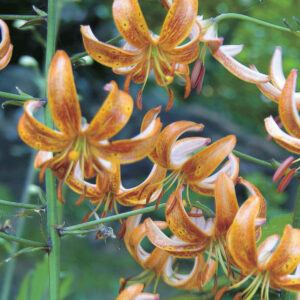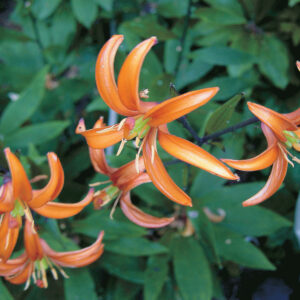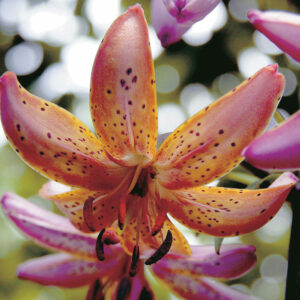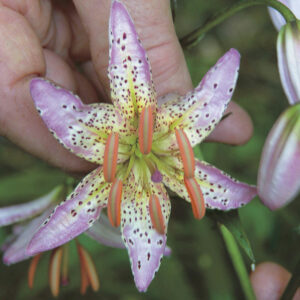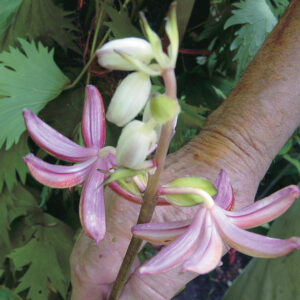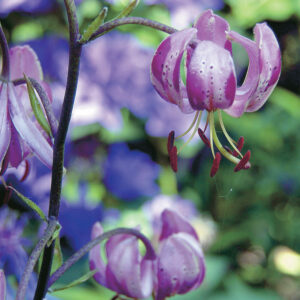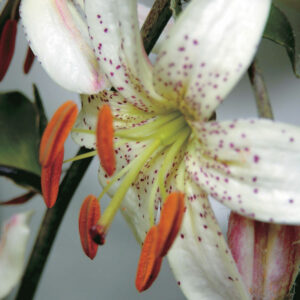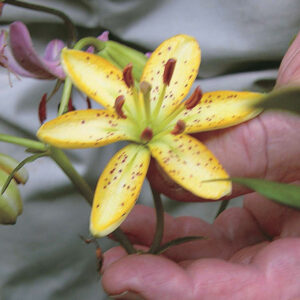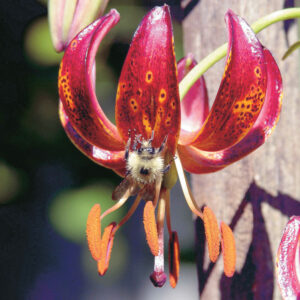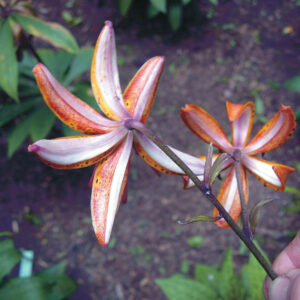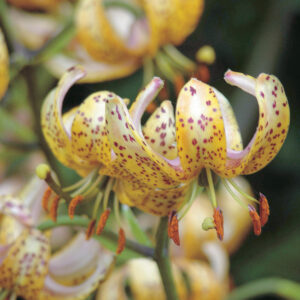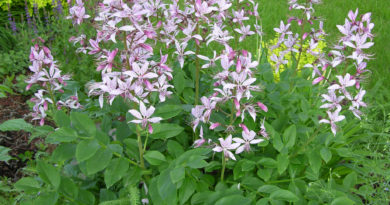Taking on the Martagon Lily
Story by Eileen Rosen
Photos by Susan Morgan
The wind whips the water and howls among the rocks. We leave its fury on shore, follow a zigzag path cut through a birch forest and walk into a ballet. Hundreds of tall martagon lily stems sway in rhythm with the wind. Bits of sun glint off the white birch bark and dance among the diminutive Turkscap lilies. Dr. Reg Gallop has carved his Garden of Eden out of the primordial boreal forest that straddles the southeast shore of Lake Winnipeg. Here he grows, breeds and trades martagon hybrids with the express purpose of registering and introducing select bulbs for the horticultural market.
The work requires the patience of Job and the discernment of a Renaissance pope. A seed takes five to seven years to produce blooms. Another five years is taken to study its health and performance. The vigour of the “individual” needs to be tested. Hundreds of seedlings and the long-range scope of his plans suggest the secret to eternal youth. Dr. Gallop was 80 when I first visited.
Martagon lilies are the oldest cultivated and least known of garden lilies. Garden centres seldom, if ever, carry them. Large-scale breeders ignore them for very good reason. Martagon lilies do not like to be bought and sold. They resent disturbances and sulk when moved. After a wait of two or three years the gardener is rewarded with a stem of diminutive lilies blooming at the same time as peonies and iris, either of which reward with sumptuous flowers at a fraction of the cost.
For the gardener who has everything, or who wants something different, the martagon and their hybrids give bragging rights.
Unlike the colourful rambunctious Asiatic hybrids, which demand a place in the sun and division every few years; or the attenuated trumpets whose stems have to be lashed to stakes lest they topple, the martagons prefer to be planted in semi-shade and left alone. They will eventually expand to a sizeable clump six feet in diameter, and as high. The English garden in Assiniboine Park has particularly fine examples.
Martagons not only prefer shade; they look better in the subdued light. The species L. martagon varies in colour from white, in m. album, through various shades of dusty mauve pink to dark maroon. The colour, in Dr. Gallop’s words, is “site specific”. Their natural habitat is the mountainous area of Europe from Spain to Siberia. Growing on steep hillsides in the shadow of forests, their colour depends on the region and the altitude. Their natural habitat provides the sharp drainage they require. The sturdy clay-laced soil of the Red River Valley is sure death. Give them a stratum of gravel under raised beds. Amend the soil heavily with coarse sand and leaf mold. Mulch, mulch, mulch with more leaf mold, and you’ll have simulated their natural home.
If you give them a good home, martagons and their hybrids will prolifically self-seed. The seed heads are a bonus. Translucent Chinese lantern shaped seedpods glow in autumn light.
Ferns and hostas are good companions. Their leafy greens provide texture without upstaging the delicate colour of the martagons. Dr. Gallop has underplanted his martagons with wood violets for early colour and a natural weed smothering mulch. Our wild columbine, Aquilegia Canadensis, would provide an excellent counterpoint.
Hybridizers, of course, insist on improving nature. Over 100 years ago, the Dutch plantsman, Van Bergen, crossed the dainty 1.5-foot mauve martagon with its Asian counterpart L. hansonii, a tall vigorous species, with heavily freckled orange Turkscap lilies. Their texture has been compared to orange peels. The offspring, L. x marham proved to be a tall healthy, but dull, child. Further crossings produced other hybrids: ‘Mrs. R.O Backhouse’, ‘Dahansonii’, and ‘Brocade’, all heavily freckled, tall and robust. None seemed able to overcome the legacy of the original dull child.
Dragon Bulb Farms introduced the ‘Paisley’ strain in the 1950s before they gave up. These are the most frequently encountered martagon hybrids. Described euphemistically as soft pink, peach, cream or yellow, in layman’s terms they are all various shades of freckled tan, with hints of mauve, rose or orange depending on the seedling. Dr. Gallop took pains to describe the differences: they are esoteric. Except for a notably dark stately x dalhansonii stem, the martagon hybrids blended into shades of warm buff tones.
Enchanting in this isolated massed situation, the martagon hybrids have proved too elusive in colouring or character for the majority of gardeners.
A much more exciting offering in Dr. Gallop’s garden are the later hybrids from the late prairie breeder, Ed Robinson. Robinson’s crosses with L. medeoloides, and L. tsingtsing produced clear oranges, scarlets and cinnabar reds on tall stems shimmering under the flickering light cast by the birch leaves. These are must-haves, especially if you’re a city dweller cursed by a garden overshadowed by buildings and neighbours’ trees.
To dedicated plantsmen like Dr. Reg Gallop and hybridizer Ed Robinson, I raise a glass of wine. Their patience, knowledge and labour have enriched our gardens and our lives.
Eileen Rosen is a Winnipeg businesswoman and dedicated gardener.


